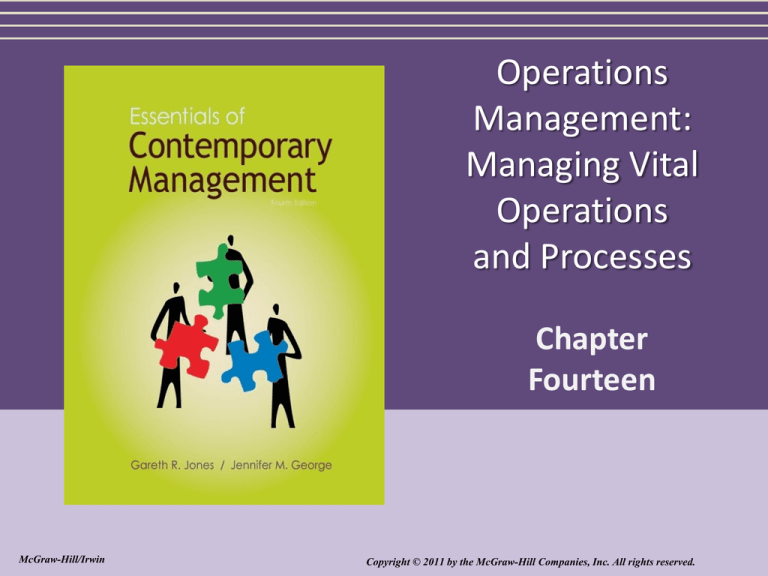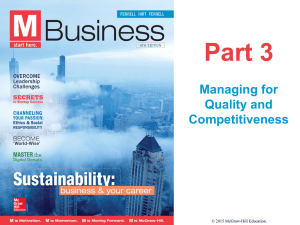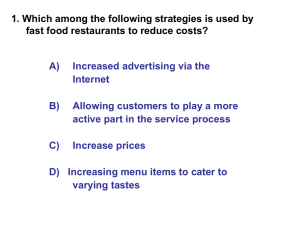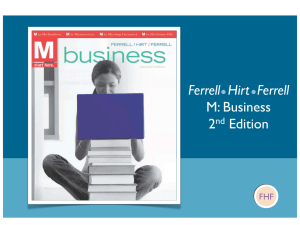
Operations
Management:
Managing Vital
Operations
and Processes
Chapter
Fourteen
McGraw-Hill/Irwin
Copyright © 2011 by the McGraw-Hill Companies, Inc. All rights reserved.
Learning Objectives
LO1 Explain the role of operations management
in achieving superior quality, efficiency, and
responsiveness to customers.
LO2 Describe what customers want, and explain
why it is so important for managers to be
responsive to their needs.
14-2
Learning Objectives (cont.)
LO3 Explain why achieving superior quality in an
organization’s operations and processes is
so important.
LO4 Explain why achieving superior efficiency is
so important.
14-3
Operations Management
• Operations
Management
– The management of
any aspect of the
production system
that transforms
inputs into finished
goods and services
14-4
Operations Management
• Production System
– The system that an organization uses to acquire
inputs, convert inputs into outputs, and dispose of
the outputs
14-5
Operations Management
• Operations Manager
– Manager who is responsible for managing an
organization’s production system and for
determining where operating improvements
might be made
14-6
Question?
What is action taken to meet the demands and
needs of customers?
A. Quality
B. Efficiency
C. Responsiveness to customers
D. Effectiveness
14-7
Operations Management
• Quality
– goods and services that are reliable, dependable,
or psychologically satisfying
• Efficiency
– amount of inputs required to produce a given
output
14-8
Operations Management
• Responsiveness to
customers
– action taken to meet
the demands and
needs of customers
14-9
The Purpose of Operations
Management
Figure 14.1
14-10
Improving Responsiveness to Customers
• Without customers, organizations would
cease to exist.
– Non-profit and for-profit firms all have customers.
– Managers need to identify who the customer is
and their needs.
14-11
What do customers want?
• Usually customers prefer:
– A lower price to a higher price
– High-quality products to low-quality products
– Quick service to slow service
– Many features over few features.
– Products that are customized or tailored to their
specific needs
14-12
Designing Production Systems to Be
Responsive to Customers
• The attributes of an organization’s outputs—their
quality, cost, and features—are determined by the
organization’s production system
• Since the ability of an organization to satisfy the
demands of its customers derives from its production
system, managers need to devote considerable
attention to constantly improving production
systems
14-13
Customer Relationship Management
• Customer relationship management (CRM)
– technique that uses IT to develop an ongoing
relationship with customers to maximize the value
an organization can deliver to them over time
14-14
Improving Quality
The concept of quality applies the products of
both manufacturing and service firms
– A firm that provides higher quality than others at
the same price is more responsive to customers.
– Higher quality can also lead to better efficiency
through lower waste levels and operating costs.
14-15
Impact of Increased Quality on
Organizational Performance
Figure 14.2
14-16
Improving Efficiency
• The fewer the inputs
required to produce
a given output, the
higher the efficiency
of a production
system
14-17
Improving Efficiency
• A common measure of the organization’s
efficiency of turning all of the inputs into
outputs is called total factor productivity:
14-18
Improving Efficiency
• A comparison measure of a single input (such
as labor) to total output is called partial
productivity:
14-19
Facilities Layout, Flexible
Manufacturing, and Efficiency
• Facilities Layout
– The operations
management
technique whose
goal is to design the
machine-worker
interface to increase
production system
efficiency.
14-20
Facilities Layout, Flexible Manufacturing,
and Efficiency
• Flexible Manufacturing
– Operations management techniques that attempt
to reduce the setup costs associated with a
production system.
14-21
Three Facilities Layouts
Figure 14.3
14-22
Discussion Question
Which facilities layout is best?
A. Product layout
B. Process Layout
C. Fixed-Position Layout
14-23
Facilities Layout
• Product layout
– Machines are organized so that each operation is
performed at work stations arranged in a fixed
sequence.
– Example: mass production systems where workers
are stationary and a belt moves work to them.
14-24
Facilities Layout
• Process Layout
– Self contained work stations not organized in a
fixed sequence.
– Provides flexibility in making a wide variety of
products tailored to customers.
14-25
Facilities Layout
• Fixed-Position Layout
– The product stays in a fixed spot and components
produced at remote stations are brought the
product for to final assembly.
– Large jet aircraft assembly uses this type of layout.
14-26
Changing a Facilities Layout
Figure 14.4
14-27
Flexible Manufacturing
• Most firms face major expenses when setting
up to produce a product.
– These costs must be paid before production
begins.
– The more often products to be built change, the
higher setup costs become.
14-28
Flexible Manufacturing
• Flexible manufacturing reduces setup costs
by reducing the time required to reset the
production line for a different product.
– Using easily replaced manufacturing equipment
– Redesigning the production system itself to be
more productive.
14-29
Just-in-Time Inventory and Efficiency
• Inventory
– the stock of raw
materials, inputs,
and component parts
that an organization
has on hand at a
particular time
14-30
Just-in-Time Inventory and Efficiency
• Just-in-Time (JIT) Inventory
– System in which parts arrive at an organization
when they are needed, not before
14-31
Just-in-Time Inventory and Efficiency
• A drawback to JIT is that a firm does not
maintain a large buffer stock of parts which
makes the firm vulnerable to strikes or supply
problems that can quickly deplete on-hand
inventories.
14-32
Self-Managed Work Teams
• Self-managed teams boost efficiency by
allowing for a flatter organization structure.
– The team takes on the role of the supervisor.
– Teams working together often become very skilled
at enhancing productivity.
14-33
Question
What is the rethinking and redesign of the
business process to achieve dramatic
improvement in critical measures of
performance?
A.
B.
C.
D.
Corporate efficiency
Process redesign
Process re-qualification
Process reengineering
14-34
Process Reengineering and Efficiency
• Process Reengineering
– The fundamental rethinking and radical redesign
of the business process to achieve dramatic
improvement in critical measures of performance
such as cost, quality, service, and speed
14-35
Process Reengineering and Efficiency
Process Reengineering:
• Boosts efficiency by directing efforts to activities that
add value to the good or service produced
• Top managers must support efficiency improvements
for them to be accepted by workers
14-36
Video Case: CVS
How can a company like CVS grow in size yet
maintain its organizational agility?
How does CVS respond to its customers?
14-37










